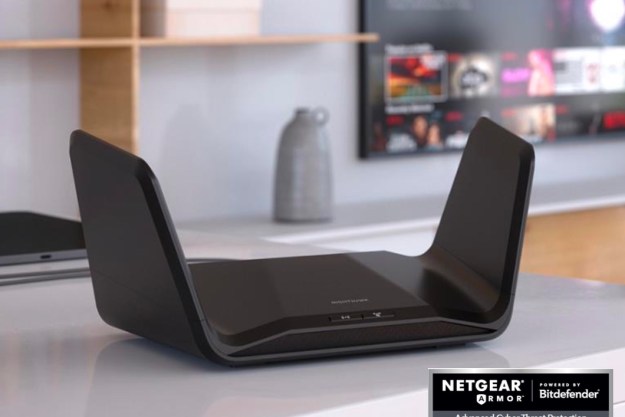
Sharing isn’t easy
To get a proper understanding of how MU-MIMO works, let’s take a look at the way that a traditional wireless router handles data packets. Routers – probably including the one you use – are very good at sending and receiving data, but only in one direction. In other words, they can only talk to one device at a time. If you are getting video streamed onto your computer, your router cannot also be streaming online video gameplay to a console.
“But wait,” you’re saying, “I can’t count the number of times that I’ve played video games while my SO watches Netflix on the laptop, so this is clearly wrong.” Yes, you can run multiple devices on your Wi-Fi network – otherwise, what would be the point? But older routers accomplish this by acting like a machine gun mounted to a merry-go-round. They rattle off bits of data very, very quickly to multiple devices in turn.

Much like how film tape looks like a constantly moving image instead of a bunch of stills, accessing Wi-Fi feels like a constant connection to the Internet because the router switches between devices so quickly. However, it can only pay attention to one device at one time, which is one reason why Internet quality goes down if Wi-Fi bandwidth is too low.
This works. It works so well that we rarely think about it. But the people who do think about it have long believed that it could work better. What if you could have a router that transmits data to multiple devices simultaneously? Wouldn’t it increase efficiency, be faster, and allow for more interesting network configurations? So advances like MU-MIMO were developed and eventually included into today’s wireless standards. These developments allow advanced wireless routers to communicate with several devices at once.
A brief history: SU vs. MU

Let’s talk about SU-MIMO vs. MU-MIMO. They sound like Pokémon, but are actually different ways to get routers to talk to multiple devices. SU-MIMO (single user, multiple input, multiple output) is older.
The SU standard allowed routers to send and receive multiple streams of data at the same time, based on the number of antennas it had. Each antenna could handle a different device. Of course this required new lines of router with multiple antennas, but manufacturers had been looking for an excuse to stick some more knobs and points on their routers anyway. SU was included in the 802.11n standard update of 2007, and was slowly introduced in new product lines.
However, SU-MIMO did have constraints in addition to antenna requirements. While multiple devices could be connected, they were still dealing with a wireless router that could only pay attention to one device at a time – our machine gun and merry-go-round analogy. Data speeds went up, interference became less of a problem, but there was still a lot of room for improvement.
MU-MIMO (multiuser, multiple input, multiple output) is the standard that evolved out of work with SU-MIMO and SDMA (Space Division Multiple Access). Before you zone out on all these acronyms, we’ll cut to the chase and say that a lot of smart techies in universities and research labs created a way for routers to hold multiple conversations at the same time. With MU, the wireless router base station is able to communicate with multiple devices using a separate stream for each, as though each device has its own personal router.
Read: TP-Link shows off new Archer C2600 router with MU-MIMO support
Eventually MU became feasible enough to be added to an 802.11ac update in 2013. After a few years of product designing, manufacturers started incorporating the feature into their lines.
Benefits of MU-MIMO
MU-MIMO is an exciting development because it has a noticeable impact on everyday Wi-Fi use without directly changing bandwidth or other key factors. It just makes networks much more efficient.
When using this new standard, you don’t need multiple antennas porcupining out of your router, and have a more stable Wi-Fi connection for your laptop, phone, tablet, or computer. Every device can be spoiled child and avoid sharing its data stream with anyone else. This is particularly noticeable when streaming video or performing other demanding tasks. Your Internet speed feels faster and more dependable, although it’s really just smart networking at work. You may also be able to use more devices on your Wi-Fi at once, which is handy when friends come over to visit.
MU-MIMO may be great, but it also has a couple limitations worth mentioning. Current standards support four devices, but add more than that and devices will have to share a stream, which brings us back toward SU-MIMO problems. It is primarily used in downstream communication, and is limited when it comes to upstream (at least for now). Also, MU has to juggle more information about your devices and channel states than previous standards. This makes managing and troubleshooting MU networks more complicated.
How to get MU-MIMO
Buy a new router and computer. Okay, it may be a little more complex than that, but you get the gist. This year manufacturers started showing off their MU-MIMO prototypes at trade shows and getting ready to announce product release dates. By 2017, you can expect it to be a common feature.
Read: Netgear is releasing the Nighthawk X8, A Wi-Fi router supporting up to 5.3GBps
When buying a wireless router, look for “MU-MIMO” in the product description or specs. As with other new features, marketers like using it as a value point, so it should be pretty easy to tell if your router can handle MU networking based on the blurbs. One of the few examples on the market in 2015 is the Linksys EA8500 Max-Stream, if you want to buy right away.
Read: Linksys starts taking preorders for its lightning fast EA8500 router
Of course, if you wait MU-MIMO will eventually come to you. This is a smart move, because most today’s wireless devices aren’t made for MU-MIMO – they force routers to revert to SU-MIMO. Until all your devices support the MU, it won’t do much good. But that day is coming.
Editors' Recommendations
- Laptop buying guide: what to look for in 2024
- What is SATA? Here’s everything you need to know about it
- What is a CPU? Here’s everything you need to know
- A beginner’s guide to Tor: How to navigate the underground internet
- The best mesh Wi-Fi systems for 2023






